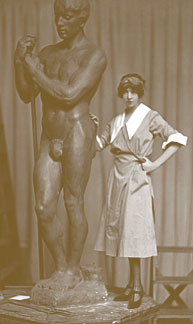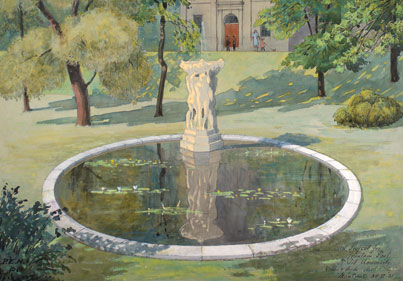The Story of the Three Bares (Page 2)
The Story of the Three Bares (Page 2) McGill University
User Tools (skip):
The Story of the Three Bares (Page 2)
An Offer We Couldn't Refuse
It was around this time that Ellen Ballon was deciding that one of Whitney's sculptures would make a wonderful gift to McGill, as a gesture of friendship between the United States and Canada. Ballon chose a ten-foot, quasi-classical sculpture that featured three mournful-looking and naked young men holding on their shoulders an earthen bowl adorned with leaves and ivy. She assembled a presentation committee of prominent Americans that included politicians and university presidents, among others, and wrote to Sir Arthur Currie that the fountain would be "a Friendship gift to McGill University by American Admirers of Canada and Mrs. Harry Payne Whitney, the distinguished Sculptress." Faith Wallis noted for Archives: "Since Mrs. Whitney offered to pay for the shipping and installation of the fountain, and since it was presented by such a committee of notables, it was a gift which the University could see no reason to refuse."

Whitney in her studio
Nicholas Murray/George Eastman House
Here the trouble started for Sir Arthur. With an elaborate ceremonial presentation of the statue scheduled for November 1, 1930, Whitney's husband, Harry, died suddenly and the proceedings were abruptly cancelled. They were rescheduled for May 29, 1931, the Spring Convocation, but this time Mrs. Whitney herself became ill and had to send her daughter to represent her. Nonetheless, Ellen Ballon was in enthusiastic attendance, as were many eminent guests on both sides.
Presenting the statue for the Americans was educator and New York Times editor John Finley. Accepting was the Governor General of Canada, the Earl of Bessborough, in his official capacity as McGill Visitor. The Depression was on, but all ignored a student waving a placard that read, "This is the most distinguished parade of the unemployed so far this year." Amid appropriate pomp, swathed in the Union Jack and the Stars and Stripes, the statue was finally unveiled and respective anthems sounded.
McGill had its Three Bares. But for Sir Arthur, two more years of headaches would ensue until his own death in 1933. Whitney had not yet come through with the money for completing the installation. The University had been paying architect Percy Nobbs to build an appropriate pool for the statue, and it had been absorbing other related costs as well: $2,050 in all, a large sum when they were cutting salaries on campus in extraordinarily tight financial times. Canadian Customs unhelpfully valued the artwork at $50,000, which McGill hotly disputed in an attempt to reduce import duties. Meanwhile, the statue in its unfinished state was boxed up the year after its unveiling.

McGill Architecture professor Percy Nobb's artistic rendering of the proposed pond for the Three Bares fountain.
Canadian Architecture Collection, McGill University
The Fountain - Finally
Growing increasingly impatient, Currie threatened to banish the thing to some less prominent corner of the campus if it was not completed soon: "I cannot leave it as it is," he wrote in frustration to Ellen Ballon. Finally, in 1933, the money arrived, pipe connections were fitted, and the pool was finished. The Montreal Herald announced, "McGill's famous fountain - which has thus far been that in name only - will become a fountain in fact." On July 4, American Independence Day, water flowed for the first time from the Good Will Fountain.
It has gone by other names: the Friendship Fountain, the Whitney Fountain, as well as the Three Graces, owing possibly, says Faith Wallis, to the analytical musings of the then Governor General's secretary, who may have forgotten the Graces are usually three young goddesses (though often portrayed in a similar formation to the Three Bares).
Whatever its muddled symbolic meaning, the statue soon suffered from very clear and unsightly rust stains: cast iron piping had been used for its waterworks. Students were quick to target the fountain as well. There was no telling when one might walk by to see the Three Bares sporting winter coats or lacy blue underwear that had been painted onto their marble rumps, or bearing the names of some unfortunate math professors. Swimsuits were a popular theme. No doubt in the interests of aesthetic symmetry, some male students proposed a statue of three naked ladies for the opposite side of the avenue.
Others expressed acid criticism. One wrote to the Daily to ridicule this "mid-Victorian mantelpiece." In the same pages, another wag suggested that "a replica could be used as a fruit bowl." Someone slightly more high-minded complained about honouring American artists at the expense of Canada's own: "France honours Tait McKenzie with his bronze group of runners... [yet] no such group ornaments his University!" (McKenzie, MDCM1892, would eventually be honoured - his statue, The Falcon, can be found on the McLennan Library terrace.)


